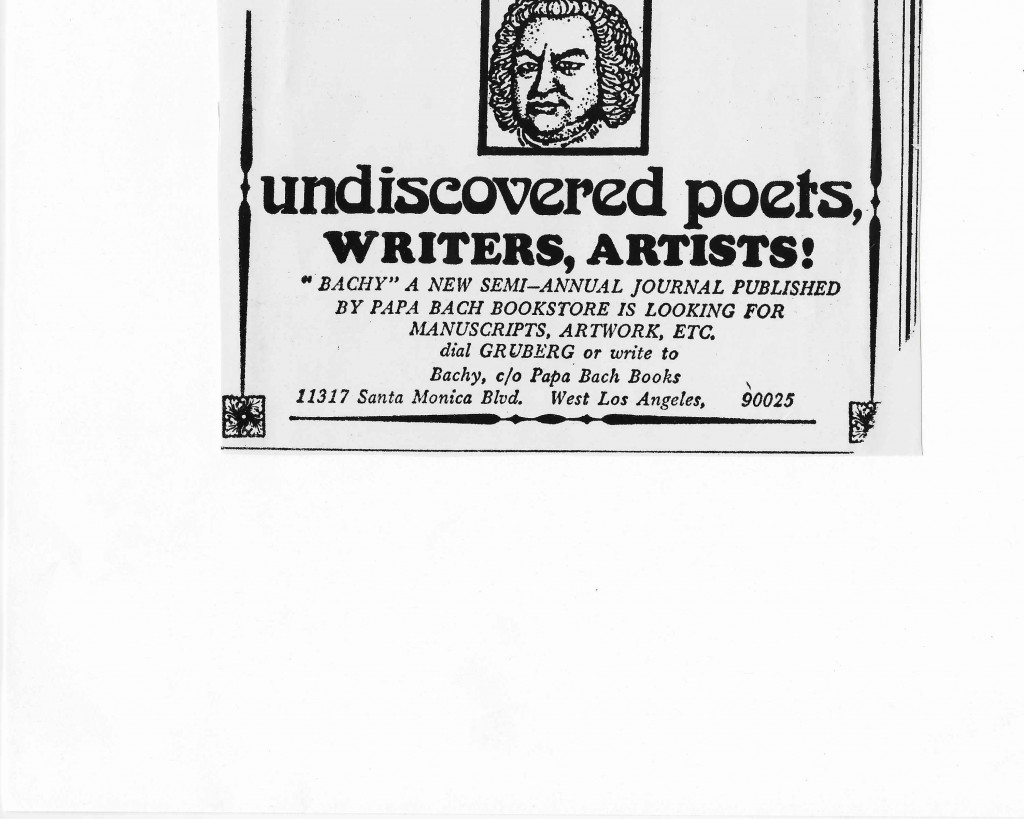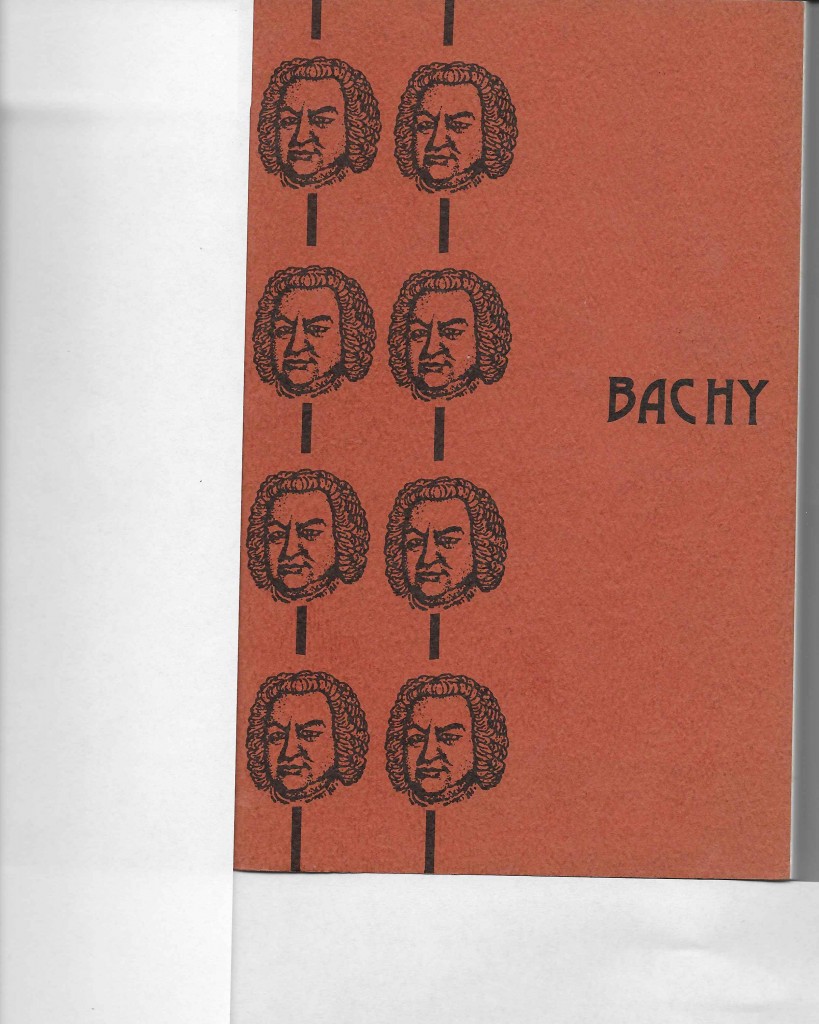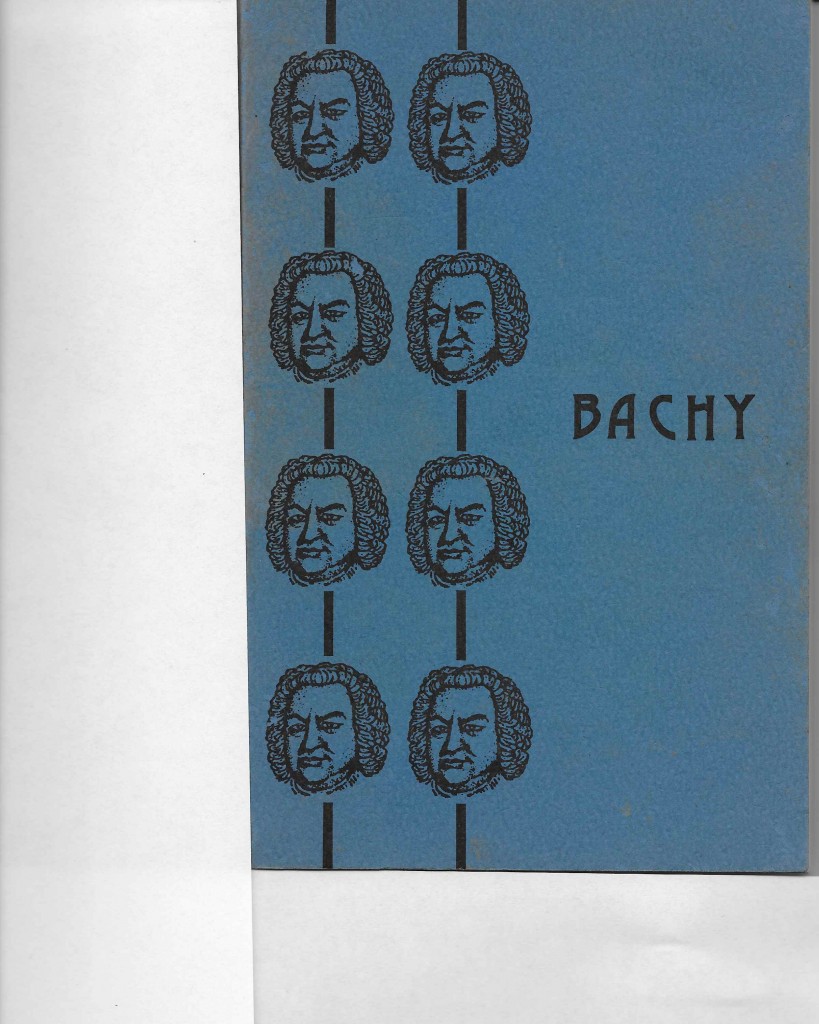July 1, 2017
The Los Angeles Times once had a Sunday section called “Calendar” that carried articles on film, theater, visual art, music and dance. It also provided free listings for a wide variety of cultural events. The section was sustained by a fairly substantial amount of advertising, including the following announcement, which appeared sometime in the early fall of 1971. The owners of Papa Bach Books had decided to start a literary magazine, which they entitled Bachy, that would primarily focus on writers and artists who were not yet “discovered.” Their choice of the poetry editor certainly fulfilled that aspiration: I was 23 years old when Ted asked me if I would take on the task of being the poetry editor, and I had not yet had a poem accepted for publication. Not wanting to rely only on word-of-mouth, Ted took out an ad in the LA Times Sunday “Calendar.”

The mail started to pour into the store, and I would sit in the rear loft at a desk in the late evening and go over manuscripts from writers who were just beginning the process of getting repeated rejections. In general, I wrote back a comment on at least one poem that every person sent. As an editorial apprentice, I found myself a better judge of other’s writing than of my own. Perhaps the fact that I exuded more confidence in that regard was the key factor in being asked to be the poetry editor of Bachy at such a young age. In many ways, I found myself making use of my training as an actor just as much as all the reading I had been doing on my own since I had turned 20. Reading a poem was like getting to know the character an actor wants to inhabit: what does the character want to do? Bad editors, like second-rate actors, are always engaged in a reductionist agenda in which they appropriate the other personality for their benefit. Good editors are akin to benevolent actors, in that they accentuate the potential of the character to discover something unexpected. At the same time, the task of the editor is more rigorous than the translator in being faithful to the character of the poem. It turned out that I was a much better editor than an actor, though learning what makes theater theatrical as I set about editing poetry was extremely helpful.
The first issue appeared in the summer of 1972, and led off with poems by Jack Hirschman. The bulk of the poems came from three places, all of which represented solicitations on my part. I included poems by the poets I had met at San Diego State (Jack W. Thomas; Bob Kuntz; Marianne Johnson; Dennis Ellman); poems from the Beyond Baroque Wednesday Night Workshop (Joseph Hansen; John Harris; Paul Vangelisti; Harry Northup; Ann Christie; Luis Campos; Lynn Shoemaker; and Phil Taylor); and poems by young poets who submitted work because I had visited Philip Levine at Fresno State and asked him to tell students about this new magazine (David St. John; Roberta Spear; Sam Pereira). There were other poets, too, I would never meet: Pedro Montez, Anna Hernandez, Beau Beausoleil, as well as poets who were hardly “undiscovered”: William Matthews, John Haines, A. G. Sobin, and Charles Bukowski.
The graphic on the front cover was borrowed from the bookmark that the store gave away with each purchase. The back cover on each of the first two issues simply continued the front cover. The spine of the first two issues featured the only exterior information about the magazine (Volume 1, No. 1; July, 1972; and Volume II, No. 1; July, 1973).


The highlight of the second issue was Leland Hickman’s opening sections of “Tiresias.” The first issue had proved to be more expensive than the owner of the store anticipated, in part because he spent too much on paper stock. It was very high quality stock, and was almost trying too hard to be impressive in its production values. The second issue cut back in size, but I was still able to include John Harris and Harry Northup, along with Lee Hickman. Lyn Lifshin had done a reading tour of the West Coast, and I accepted one of her poems after she read at the store. Unknown poets included Sandra Tanhauser; Rick Smith; Frances Thronson; Bonita Hearn; and Pedro Montez, with whom I lost contact after this issue. One of the poets was still an undergraduate: Jim Grabill was a senior at Bowling Green State University. I continued to publish him after I started Momentum magazine in 1974, and his book, ONE RIVER, was the first one I published in my Momentum Press project.
 About Bill Mohr
About Bill Mohr